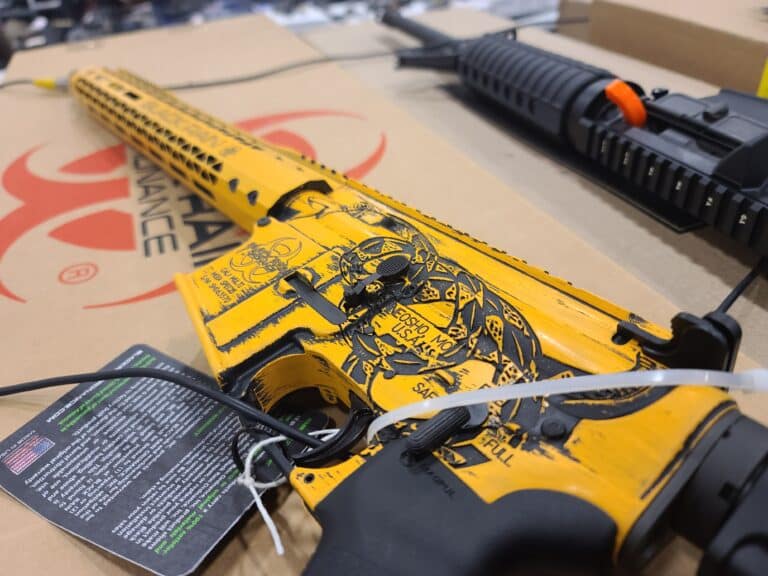“[T]he Court finds that braced pistols regulated under the Final Rule are commonly used by law-abiding citizens for lawful purposes.”
That may be the most influential finding in Judge Reed O’Connor’s decision enjoining the ATF’s pistol brace rule. It strikes at a key part of the fight over gun and accessory bans across the country. And how Judge O’Connor reached his conclusion provides new insight into the threshold other courts may employ to determine whether the Second Amendment protects a banned item.
Working off of Supreme Court precedent in 2008’s District of Columbia v. Heller, 2010’s McDonald v. Chicago, and 2022’s New York State Rifle and Pistol Association v. Bruen, Judge O’Connor established the test for whether the Constitution protects an arm is whether it’s in lawful common use or not. And he said the Court had already determined modern handguns fit the bill.
“A weapon is in ‘common use’ rather than ‘dangerous and unusual’ if it is ‘commonly possessed by law-abiding citizens for lawful purposes today,'” he wrote. “The relevant inquiry under this standard is the current total number of a particular weapon that is in lawful possession, ownership, and circulation throughout the United States. As a per se matter, semiautomatic pistols are commonly used weapons for lawful self-defense purposes across the United States today.”
From there, he found adding a brace to a pistol “does not somehow alter that status and effectively strip these pistols of their Second Amendment protection.” Then he argued the ATF’s own estimate for how many braced pistols have been legally purchased over the years directly undercut its argument they could be banned or significantly restricted.
“The Government Defendants’ assertion to the contrary—that pistols do become dangerous and unusual as soon as stabilizing braces are attached to them—does not survive its own administrative record,” Judge O’Connor wrote. “The ATF’s regulatory analysis concludes that there are between 3 and 7 million, with a fifty percentile estimate of 5 million, braced pistols under the ownership of law-abiding individuals for lawful purposes throughout the United States.”
That estimate comes from the agency’s impact assessment for the rule. But those numbers are actually on the lower end of the spectrum. The Congressional Research Service found braced pistols are even more common, estimating there are between 10 to 40 million in civilian hands. Regardless, Judge O’Connor argued the fact that everyone agrees there are at least millions of these guns puts them squarely in the “common use” category.
“In the Final Rule publication as well, ATF did not dispute noteworthy public comments pointing out that ‘millions of ‘braces’ are in use’ and that braced pistols are ‘commonly used by millions of law-abiding Americans for various reasons,'” he wrote. “On the other hand, ATF even conceded that since 2012, ‘the variety of available ‘stabilizing braces’ or similar ‘brace’ devices and pistols equipped with ‘braces’ has grown significantly.’ Supreme Court guidance and sister circuit precedent postulate that this record is dispositive of the matter.”
Judge O’Connor isn’t alone in this determination either. When a Fifth Circuit Court of Appeals panel reviewed the ATF’s rule, it blocked it after finding the agency exceeded its statutory power. However, Judge Don Willett wrote a concurrence where he also argued that braced pistols are in common use and protected by the Second Amendment.
“Rearward attachments, besides making a pistol less concealable, improve a pistol’s stability, and thus a user’s accuracy. Accuracy, in turn, promotes safety,” Willett wrote in a concurrence. “In my view, protected Second Amendment’ conduct’ likely includes making common, safety-improving modifications to otherwise lawfully bearable arms.”
Supreme Court Justice Samuel Alito has also opined on this point in a concurrence. While 2016’s Caetano v. Massachusetts was primarily about establishing the Second Amendment extended to modern-day arms, he argued the existence of as little as 200,000 stun guns made them protected.
“The more relevant statistic is that ‘[h]undreds of thousands of Tasers and stun guns have been sold to private citizens,’ who it appears may lawfully possess them in 45 States,” he wrote. “While less popular than handguns, stun guns are widely owned and accepted as a legitimate means of self-defense across the country. Massachusetts’ categorical ban of such weapons therefore violates the Second Amendment.”
But even if you back off to Judge O’Connor’s standard that millions of the affected arms have to be in civilian hands to be protected, that has massive implications for some of the most contentious gun laws in the country. Nearly every high-profile hardware ban would likely be affected because of how popular their targets are with Americans.
The prevalence of different guns and accessories is often challenging to quantify because most aren’t registered. Estimates are generally inexact at best. For instance, nobody keeps track of how many ammunition magazines are produced each year, and estimates of their popularity are probably among the least reliable. The disparate nature of various state magazine bans, with different states setting capacity limits at 10 or 15 or 17 rounds, also limits how accurate estimates of affected arms can be.
Still, so-called high-capacity magazines are probably the most common of the banned arms out there today. The vast majority of modern handguns and semi-automatic rifles come standard with multiple magazines that at least hold more than 10 rounds of ammunition. Plaintiffs in one suit against Rhode Island’s ban estimated there are 115 million in circulation, according to Courthouse News Service. Even if they’re off by an order of magnitude, that still puts the magazines comfortably in the realm of protected arms under Judge O’Connor’s reasoning (of course, there’s also a live legal debate over whether they qualify as arms at all).
A number of federal judges have already come to this conclusion since last year’s Bruen ruling. Most recently, Judge Roger Benitez determined California can’t ban magazines because they are in common use.
“This case is about a California state law that makes it a crime to keep and bear common firearm magazines typically possessed for lawful purposes,” Judge Benitez wrote in Duncan v. Bonta. “Based on the text, history, and tradition of the Second Amendment, this law is clearly unconstitutional.”
The estimate for how many AR-15s and similar firearms, often targeted in “assault weapon” bans, is smaller than that of magazines but also a bit more reliable. The National Shooting Sports Foundation, the gun industry’s trade group, reported last year that more than 24.4 million AR-15s and AK-47s are in civilian hands. That number was pulled from decades of ATF manufacturing reports, which don’t track specific models but do give a general overview of firearm type.
That puts ARs comfortably into the millions, even if it ends up being an extreme overcount. The number of rifles in circulation hasn’t been key thus far in the post-Bruen assault weapon ban cases, most of which haven’t gotten as far as similar magazine challenges, but it’s likely to determine whether those bans ultimately stand or fall.
The number of silencers in circulation is smaller still than AR-15s, but the estimate of how many exist is also more reliable. As of May 2021, Americans have registered 2,664,774 silencers with the ATF under the National Firearms Act (NFA). That’s a very reliable count because the NFA requires civilians to register all of their sound suppressors with the agency or face potential prosecution. That puts the number of silencers slightly below the ATF’s estimate for the number of braced pistols. But not by much.
That could make a future challenge of the NFA’s registration requirements viable, at least as they apply to silencers.
Of course, gun-rights activists have been pushing courts to adopt this line of thinking since Heller was handed down 15 years ago. And Judge O’Connor is just a district court judge. His ruling isn’t binding on anyone but the parties to the case. Other federal judges don’t have to follow his reasoning. The same is true of single-judge concurrences, even all the way up at the Supreme Court.
But, if Judge O’Connor’s standard for determining “common use” proves to be influential, it will upend gun policy in the ways gun-rights advocates have been hoping, and gun-control advocates have been dreading, for a generation.






